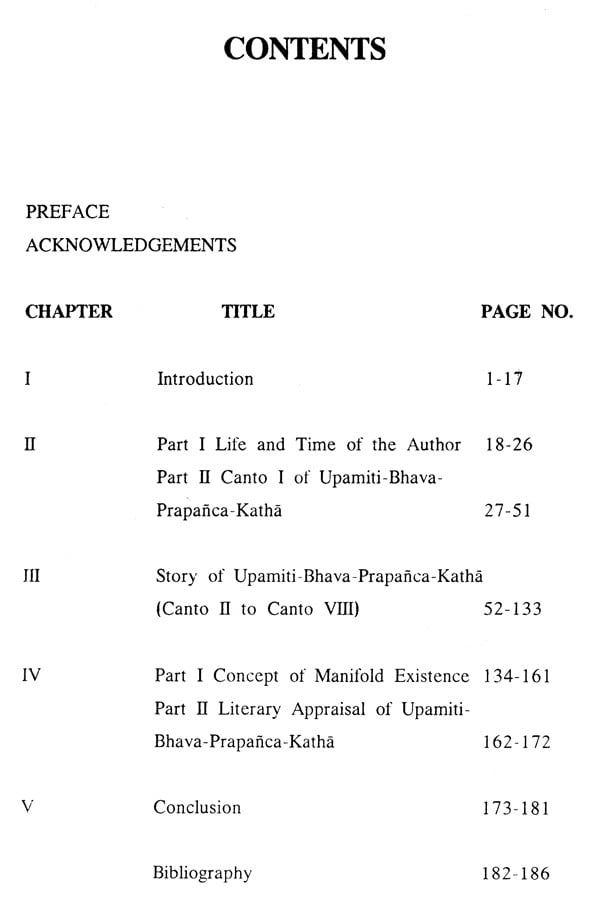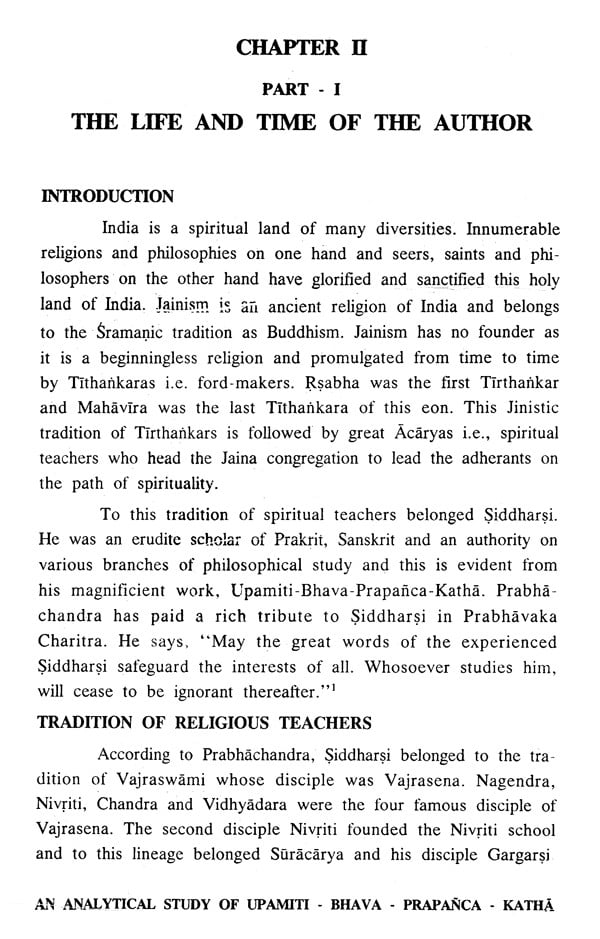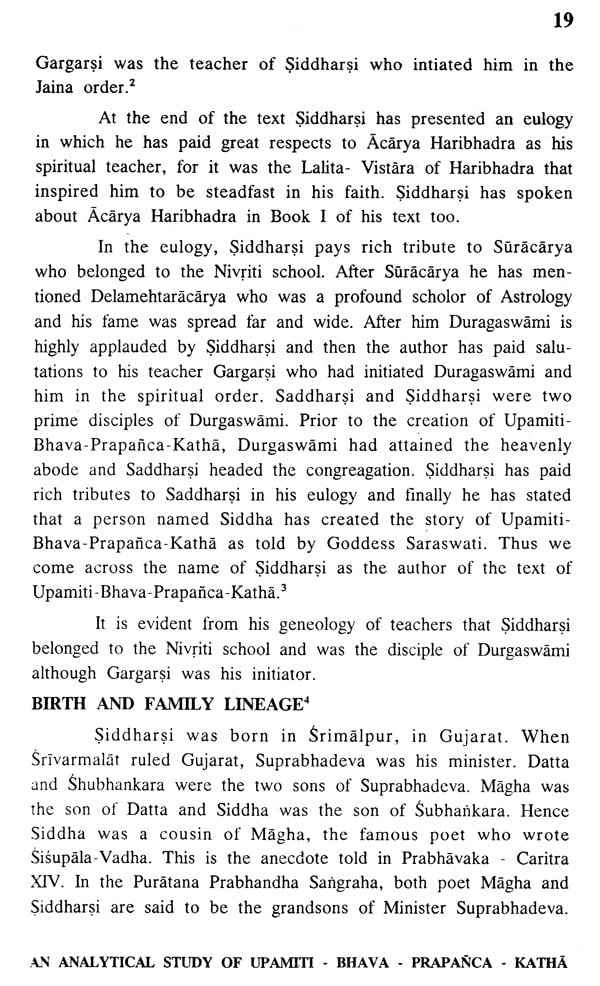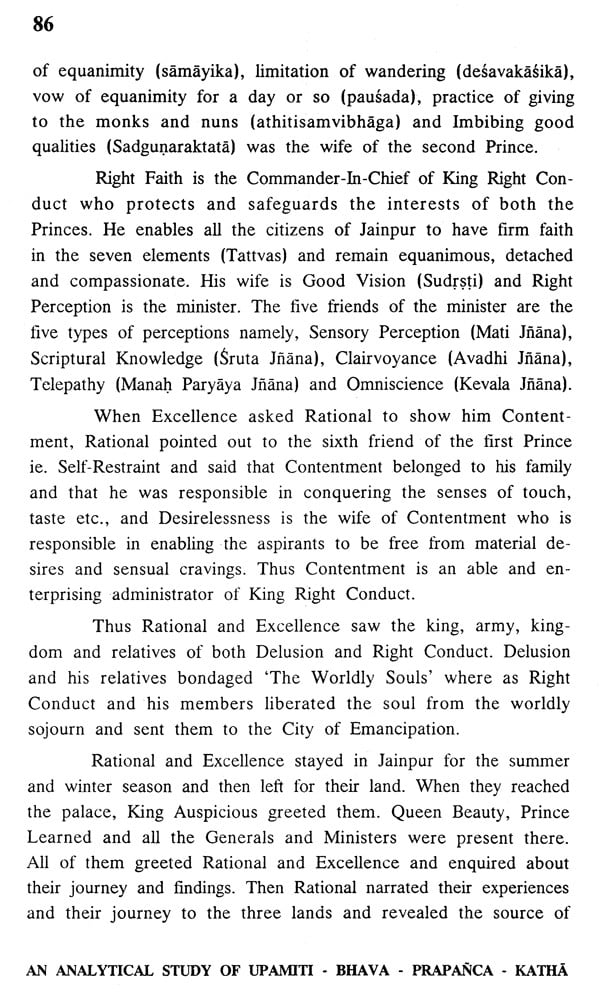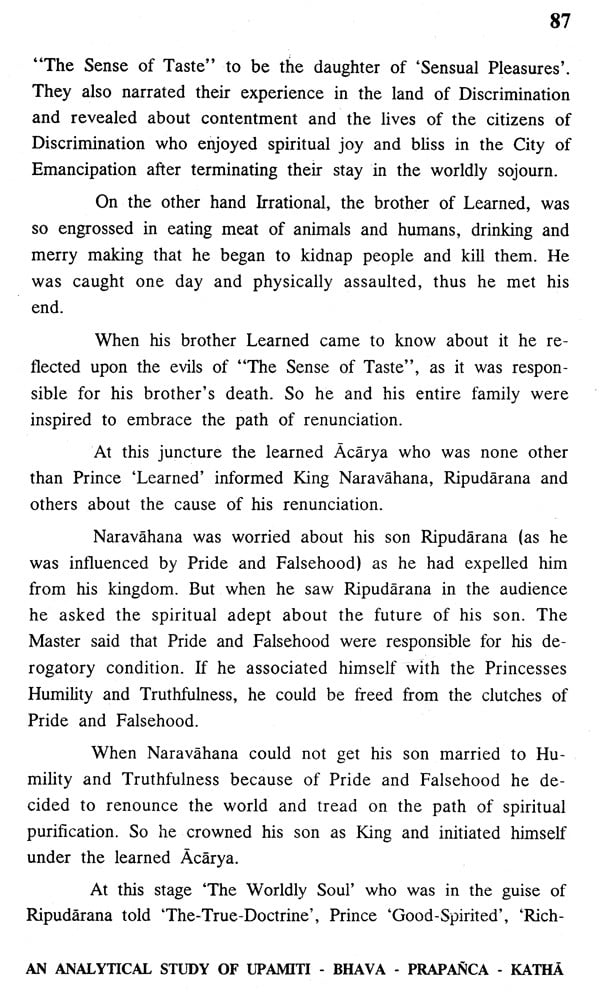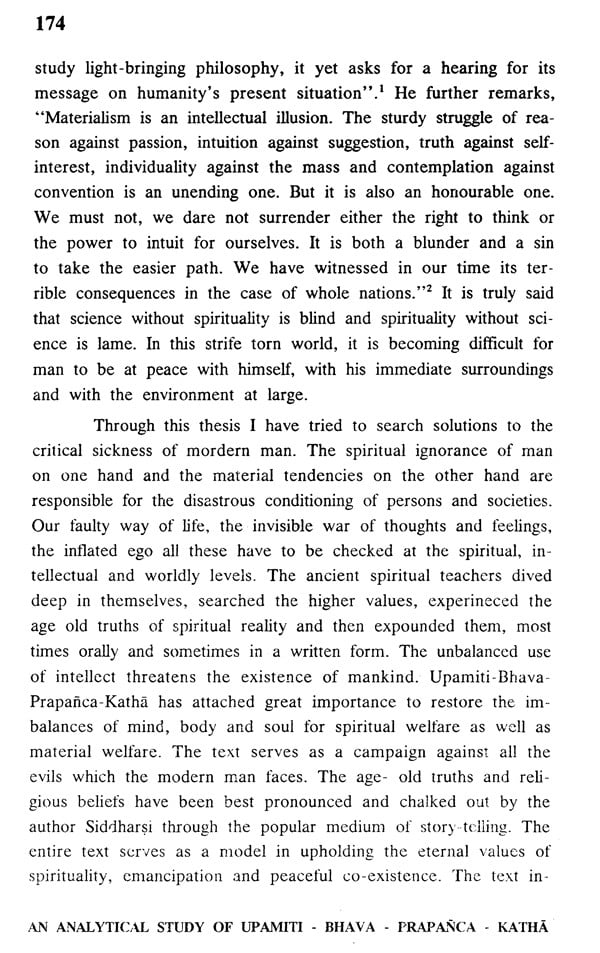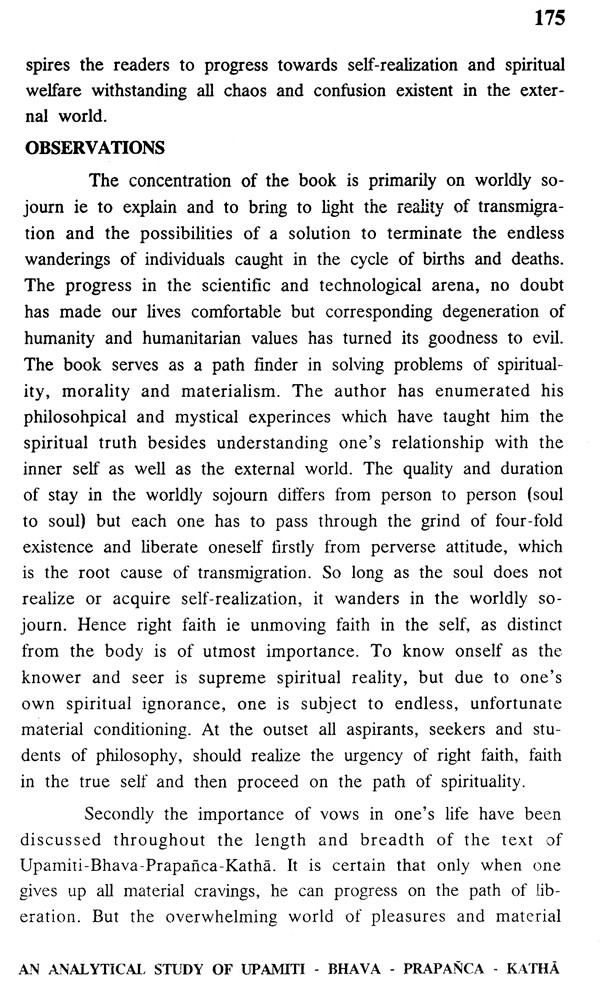
An Analytical Study of Upamiti-Bhava-Prapanca-Katha
Book Specification
| Item Code: | UAB147 |
| Author: | Priyadarshana Jain |
| Publisher: | Prakrit Bharati Academy, Jaipur |
| Language: | English |
| Edition: | 2008 |
| ISBN: | 9788189698249 |
| Pages: | 200 |
| Cover: | PAPERBACK |
| Other Details | 8.50 X 6.00 inches |
| Weight | 250 gm |
Book Description
I have made an analytical study of the 10th century text of UPAMITI-BHAVA-PRAPANCA-KATHA, in this thesis. My aim was to study and evaluate the uparalleled allegorical text of Upamiti-Bhava-Prapanca-Katha written by Siddharsi. The subject matter of the text inspired me to take up this research study. It is marvellous indeed that the author has interwoven an entire tale with philosophy and expounded the concept of manifold existence, which cannot be confined to a particular philosophy or religion.
Jaina ethics and metaphysics have stemmed from the spirituality experienced and expounded by Tirthankars and Arhats. The same tradition of spiritual purification and termination of the worldly sojourn has been pronounced in the text of Upamiti-Bhava-Prapanca-Katha in lucid Sanskrit. Prior to commencing the story of Upamiti-Bhava-Prapanca-Katha, the author has given a fore-running allegory of the Virtueless Beggar who latter becomes Rich-in-Virtue. The author has been remarkably straight-forward in saying that the Virtueless Beggar is none other than himself.
I have divided the thesis in five chapters. The first chapter is an Introduction to Story Literature.
The second chapter is divided in two parts. Part-I is about the life and time of the author and Part-H is Canto I of Upamiti-Bhava- Prapanca-Katha, which enumerates the fore-running allegory of the Virtueless Beggar. In the third chapter, the story of Upamiti-Bhava- Prapanca-Katha is told from Canto II to Canto VIII. The fourth chapter is divided in two parts. In Part I the concept of Manifold existence is discussed through the study of concepts of Atman, Karman and Emancipation and Part II is a literary appraisal of the text of Upamiti-Bhava-Prapanca-Katha. In the concluding fifth chapter I have discussed the observations and the significance of the above study in modern times.
The above research study has enriched my knowledge of the fundamentals of Jainsim and my faith in them. It has given me immense spiritual satisfaction and I feel blessed for the same. I hope all aspirants and readers enjoy studying this book and enlighten themselves of the facts of life and right living.
Life of man today is multi-dimensional and multi-faceted. Science, technology, civilization, economics, power and politics have enabled man to scale new heights and greater horizons. The high skies, the deep seas, the wide oceans and the thickest for-ests have been explored by man in quest of happiness and truth. The glaring disparity between science and spirituality is so evident in recent times, that inspite of the mind, machine and motor, our hearts remain empty of peace and happiness. Man has challenged and investigated all the forces external to him but one dimension, challenge and investigation that endures him is his ownself. The price that he is paying for the so called cultural, advanced and civilized life is so high that he has practically no time to look into his ownself. It has been felt that in the light of scientific dy-namism, spiritual dynamism has been ignored, which needs to be attended to urgently, to save the world of another war, calamity, chaos and confusion.
Science and spirituality though poles apart have co-existed since times immemorial and have played vital roles in shaping the history of mankind. Science studies and explores the external material world, where as spirituality is confined to the inner realms of the self. Science is based on experiment while spiritual-ism is the fruit of experience. Research and experiments of science have been carried from the atom to the cosmos while spirituality takes pride in answering queries of perfection and imperfection, conditioning and unconditioning of the self, bondage and liberation, ethics and aesthetics, metaphysics and philosophy.
The wonders of science and search of the truth are exclusively a human privelege and this includes the faculty of reading, writing and telling tales. Stories, tales, fables and parables have been an intergal part of any literature and a powerful source of entertainment and education in any society. The history of story-telling is as old as the history of mankind. The vast treasure house of stories have been the back bone of any civilization. The customs, traditions and rituals of the people of different lands are preserved in the form of stories and tales and a comprehensive study of the same enables us to understand their culture and his-tory in the right perspective. Stories depict the life of the people and on the contrary lives of people are influenced by stories.
Through their progressive outlook and insight in life, story tellers and epic writers have created history and contributed to the evolution of mankind. The art of story telling is not heriditary of any particular community, religion or nation but is universal and so is its popularity and impression upon mankind. As Jagdish Chandra Jain says, "Tales reflect various social, cultural, eco-nomic, political and geographical conditions including the diversity of customs and habits prevalent in different regions and peculiarities of physical features, temperament and nature of the people." He further says, "A story teller while narrating a story repeats, exaggerates and dramatises his narration in order to fascinate his audience."'
Since ages stories have not only been entertaining but gearing and discplining young and old alike with the golden principles to guide them onto the road leading to success in life. Directly and indirectly they tell us of ways to deal with whatever we face in life. Aristotle describes stories as a kind of cleansing of emotions.' The Arabian Nights, the Aesop's fables, the stories of Pancatantra and Hitopadesa need no introduction. The popularity of Pancatantra is evident from the fact that it has been translated in almost all Indian languages and more than fitly foreign languages. Following the Pancatantra is the Hitopadesa, which is famous world wide for the animal stories. These primitive animal stories are life-like as the animals behave like human beings and are symbols of human mankind. Maria Leach observes, "An animal tale is one of the oldest forms perhaps the oldest of the folklore and found every where on the globe at all levels of culture.' These stories do not bear any spiritual or philisophical significance but have a didactic tone dealing with down to earth desires, fears and agonies of man faced by him in his day to day life.
The text of Upamiti-Bhava-Prapanca-Kath? is one of its kinds. It is an allegorical work explaining the concepts of soul, karma, rebirth and liberation. Siddarshi has woven an entire tale in 18,000 slokas in the 10th century. This work primarily focuses on the worldly sojourn of the soul ie transmigration of the soul from one life to another since time immemorial and inspires a person to find solution to the endless and purposeless wanderings of individuals who are caught in the infinite cycle of births and deaths. There is one duty of all souls worth executing and that is self-realisation. This is revealed through the entire work and this is the essence of Jaina philosophy. Passions, which spring from ignorance and delusion play havoc, are the root cause of misery and transmigration. It is indeed surprising that in this materialistic age, the beacon call of spirituality is revealed meticulously throughout the work in simple language by the author and then by Dr Priyadarshana in this work. The age-old tradition of story-telling has been carefully interwoven with the Jaina philosophy. The language is lucid and the style of narration is simple and the contents thought provoking. The work is indeed the biography of the transmigratory soul caught in the web of birth, death, old-age and misery.
Story telling is a very powerful tool of communication and, therefore, popular in all times. A reader/listener of a story identifies himself or herself with the different events in the story and is forced to think whether the experiences in the story are different from his/her own experiences. There is an appreciation of good or bad events that take place in the story and a feeling of sympathy/ apathy is generated for the different characters. Language becomes a controversial subject when the purpose is to communicate across times and people. A story is usually told in the popular language which is well understood by all or many. Siddarshi chose to write in easy and popular language. If a person writes in the language of learned people, one gets respect from them alone and its contents are not known and understood by the people at large. If a person writes in a popular language, one gets admiration and popularity from the common-man. In a country like India, choice of language remains a controversial subject, no matter what language you choose to write, some segments of the society will not get the benefit or get isolated.
An effective way to communicate an idea is not to discuss theories and confuse people on a particular issue. This may also lead to conflicts and arguments. Therefore, the best way to convey any idea howsoever difficult it may be is to narrate a story and share the experience. Theory seems to be based on hypotheses, concepts, speculation, potential, unproven things and sometimes impractical ideas while stories enable one to understand what an institution is about - new stories, old stories and learning experiences; it also relates to happenings and even realising what seems to be a fantasy. Stories are about people while theories are about instruments or ideas. The story method of conveying a concept has an advantage over other methods in a dynamic sense. Stories are created retrospectively to make a sense of experience and realisation; then stories can also be created prospectively to explore future possibilities and outcome and make them realize the fruits bearing characteristics of present actions on future.
Dr. Priyadarshana Jain's work is divided into five parts, dealing with (i) introduction of Indian narrative literature, (ii) life and time of the author of the text of Upamiti-Bhava-Prapanca-Kath? (iii) the story of the text (iv) concept of manifold-existence and literary appraisal of the text and (v) her observations on the text and their relevance in our life. All these have been done with great care and convey a profound message. The analytical study by Dr. Priyadarshana Jain is quite exhaustive and refers to the Jain and non-Jain narrative literature and also to canonical and non-canonical narrative literature.
Jaina literature addresses the above issue in diverse ways which are broadly categorized into four Anuyogas. I would like to observe that the classification of Jaina literature as, Anuyoga is unique and unparalleled in the world literature. The four Anuyogas advocate the single theme of path of liberation and exaltation of states of Arihantas and Siddhas (Moksha).. Therefore, all virtues and principles governing such a path are interwoven in stories.
**Contents and Sample Pages**
